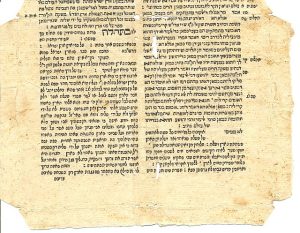Rabbinic Creativity
The Jews of medieval Europe created regularly and impressively in all three modes of Jewish law. Leading figures wrote responsa in reply to question raised to them. The responsa of such leading figures were carefully preserved and became part of the corpus of Jewish law. Ongoing study of the Talmud eventuated in the composition of important commentaries. The first of the great European commentaries was that of the eleventh-century R. Solomon ben Isaac of Troyes—Rashi—whose commentary became the standard from his days down to the present. From Rashi’s own family emerged a school of innovative commentary that, using Rashi’s observations as a base, probed more deeply into the vast “sea of the Talmud.” This new school, called the Tosafists, produced a set of commentaries that likewise became normative in subsequent Jewish academic life. The expansion of Jewish law through the responsa and through Talmud study and commentary generated the need for ongoing compilation of manuals of Jewish law, a need that was regularly addressed.
Images
- Illuminated Page from Thirteenth-Century German Mishneh Torah Manuscript
- Illuminated Page from Fifteenth-Century Portuguese Mishneh Torah Manuscript
- Rabbi Zedekiah ben Abrahamha-Rofe, Shibbolei Ha-Leket
- Illuminated Page from Fifteenth-Century Italian Arba`ah Turim, Yorah De`ah Manuscript
- Illuminated Page from Fifteenth-Century Italian Arba`ah Turim Even ha-`Ezer Manuscript
- Illuminated Page from Fifteenth-Century Italian Arba`ah Turim, Hoshen Mishpat Manuscript
Primary Texts
- The Establishment of Rabbinic Studies in Spain, Abraham Ibn Daud’s Sefer ha-Kabbalah
- History of Rabbinic Studies in France, Rabbi Moses of Coucy’s Sefer Mizvot Gadol
- History of Rabbinic Studies in France, Rabbi Menahem ben Zerah’s Zeidah la-Derekh
- Code Introduction, Rabbi Asher ben Yehiel’s Arba`ah Turim
Secondary Literature
- I. Ta-Shma, “Rabbinic Literature in the Middle Ages- 1000-1492,” The Oxford Handbook of Jewish Studies (2002), ed. M. Goodman et al. (Oxford- Oxford University Press, 2002), 219-240.
- I. Twersky, Rabad of Posquieres, A Twelfth-Century Talmudist (Cambridge MA- Harvard University Press, 1962).
- H. J. Zimmels, “Codification by the Jews of Spain,” The Sephardi Heritage, ed. R. D. Barnett (New York- Ktav, 1971), 402-424.
- H. Soloveitchik, “Religious Law and Change- The Medieval Ashkenazic Example,” AJS Review 12 (1987)- 205-221.
- E. Kanarfogel, “Progress and Tradition in Medieval Ashkenaz,” Jewish History 14 (2000)- 287-315.
- H. Soloveitchik, “Catastrophe and Halakhic Creativity; Ashkenaz – 1096, 1242, 1306 and 1298,” Jewish History 12 (1998)- 71-85.
Videos
What do you want to know?
Ask our AI widget and get answers from this website
